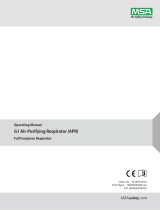Page is loading ...

1st Responders: Int0 the Face of Danger
Donning Instructions for the
MSA Millennium® CBRN Gas Mask
ID 0517-05-MC /August 2004
The following is a partial list of precautions that must be followed, or serious
personal injury or death can result:
• Know the contaminants in the environment you are about to enter. Check to
ensure that the canister you are using is CBRN approved.
• If the respirator does not perform as specified in the instruction manual,
it must not be used until it has been checked by authorized personnel.
• Wear impermeable protective clothing against gases and vapors that can
poison by skin absorption.
• Return to fresh air immediately if you experience any unusual sensations like
difficult breathing, dizziness or other distress, experience an unusual odor or
taste, experience nose or throat irritation.
• Do not wear eyeglasses under the facepiece, as the temples will prevent an
air tight seal and enable the inhalation of hazardous airborne agents. If you
must wear corrective eyewear, install the spectacle kit listed on the NIOSH
approval matrix.
• Do not use this respirator with beards, encroaching hair lines or large side
burns that prevent direct contact between the skin and sealing surface
of the facepiece.These conditions can cause face seal leakage, enabling
inhalation of hazardous airborne agents.
• Do not use this respirator beyond eight (8) hours after the initial exposure
to chemical warfare agents to avoid the possibility of agent permeation.
If liquid exposure is encountered, the respirator must not be used for more
than two (2) hours.
The MSA Millennium CBRN Gas Mask is designed to provide respiratory protection against
Chemical, Biological, Radiological and Nuclear airborne agents.
1. Remove the mask and canister from the clamshell case and
remove the canister from the foil bag.
2. Make sure the canister approval matches the contaminants
expected in the environment you are about to enter and the
canister is not damaged.
3. Thread the canister into the facepiece port and hand-tighten.
Do not use the Millennium
CBRN Gas Mask for more than
8 hours after initial exposure to
airborne agents or more than
2 hours after exposure to liquid
agents.
Return to an uncontaminated
area to remove the mask. Check
that all protective equipment
you are wearing is free of
contaminants before removing
the mask.
Insert your thumbs under each
of the harness head strap end tabs and fully extend them. Grasp
the facepiece by the speaking diaphragm and pull up and away
from your face.
How to remove the Millennium
CBRN Gas Mask:
Before donning the Millennium
CBRN Gas Mask:
2
3
6
5
4
For more information on the Millennium CBRN
Gas Mask, available accessories and other features
of MSA’s Homeland Security line of products, visit
www.MSAnet.com or call 1-888-MSA-0018
2
3
6
5
4
How to don the Millennium CBRN Gas Mask:
1. Loosen the head harness straps so that strap ends are
approximately 1 inch from the buckles. Grasp the temple and
neck straps in each hand. Slightly expand the harness, place
chin into the facepiece, and pull the harness over the back of
the head.
2. Hold the exhalation valve assembly in the palm of one hand
and with the free hand adjust the facepiece securely to the
face, making sure the chin and nose are seated securely. While
holding the facepiece in position, tighten one temple strap at a
time by pulling straight back (not outward) with small tugs
until the mask feels snug on that side. Do the same on the
other side until the mask feels secure everywhere.
Center the facepiece by looking down at the nosecup to make
sure it is uniform on both sides of the face. Adjust the temple
straps accordingly. No hair should be under the tabs or sealing
surface. The straps should not cut into the ears.
3. Evenly tighten the neck straps by pulling them straight back.
4. Check that the head pad is centered in the middle of the back
of the head.
5. Tighten the top straps for best visibility and fit, if needed.
6. Perform a negative pressure seal test before entering a
contaminated environment.
• Block the canister inlet with the palm of your hand, then inhale
gently and hold breath for 10 seconds.
• If the seal is good, the facepiece will collapse and remain
collapsed against your face. You may remove your hand and
breathe normally.
• If the facepiece did not collapse or if any leakage is noticed,
readjust the straps and perform the test again. If a leak
remains, the mask will not provide adequate protection and
must not be used.
1
1
/




